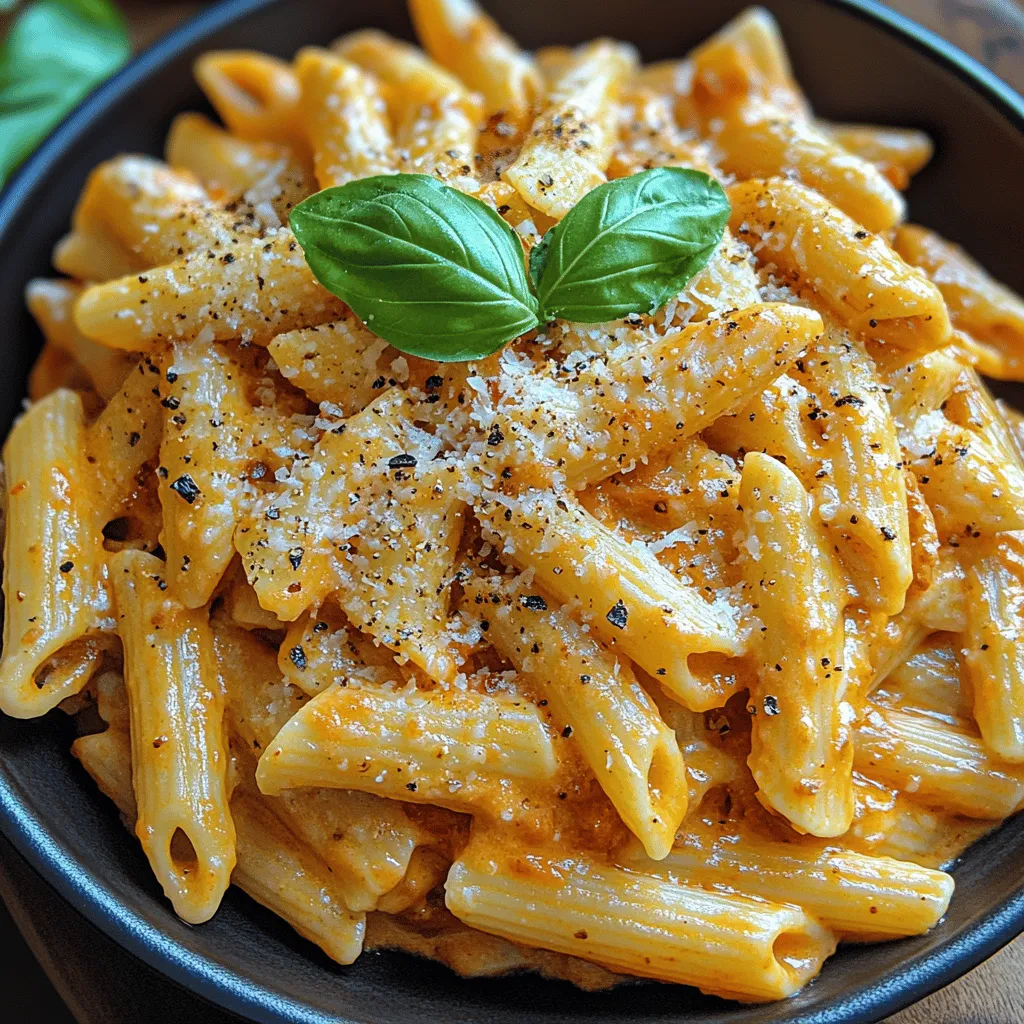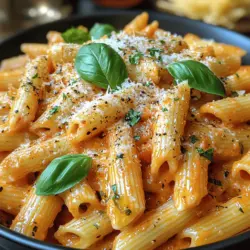Creamy Roasted Red Pepper Pasta Recipe
Introduction
Creamy roasted red pepper pasta is a dish that perfectly balances simplicity and flavor, making it a go-to choice for both weeknight dinners and special occasions. This delightful recipe combines the sweetness of roasted red bell peppers with the richness of heavy cream, resulting in a sauce that’s both luscious and satisfying. Its appeal lies not only in its taste but also in its ability to bring comfort to the table without demanding hours of preparation.
In today’s fast-paced world, easy yet flavorful meals are essential for busy individuals and families. This pasta dish allows you to whip up a restaurant-quality meal in under 30 minutes, making it an ideal recipe for anyone who values both convenience and taste. The versatility of pasta dishes further enhances their popularity, as they can be customized with various ingredients to suit different dietary preferences and flavor profiles.
Understanding the Ingredients
To create this creamy roasted red pepper pasta, it’s essential to understand the key ingredients that contribute to its unique flavor and texture. The primary components include pasta, roasted red bell peppers, heavy cream, garlic, onion, and optional seasonings. Each of these ingredients plays a vital role in crafting a dish that is both delicious and satisfying.
Pasta Varieties: The choice of pasta can significantly influence the overall experience of the dish. While penne, fettuccine, and spaghetti are popular options, each brings its own charm. Penne, with its tube shape, is excellent for capturing the creamy sauce, while fettuccine offers a broader surface area for a luxurious mouthfeel. Spaghetti, on the other hand, provides a classic twist and works well with the sauce’s consistency. Choosing the right pasta can elevate your meal, so consider your preference and the dining experience you wish to create.
Nutritional Benefits of Red Bell Peppers: Red bell peppers are not only vibrant and flavorful but also packed with nutrients. They are rich in vitamins A and C, which are crucial for maintaining healthy skin, boosting the immune system, and supporting overall well-being. Additionally, the natural sweetness of roasted red peppers adds depth to the dish, making it both nutritious and delicious.
Role of Heavy Cream: The use of heavy cream is pivotal in achieving the dish’s signature richness. Heavy cream not only adds a silky texture to the sauce but also helps to balance the flavors of the roasted peppers and spices. For those looking to lighten the dish, alternatives such as half-and-half or coconut cream can be explored, though they may alter the final flavor and texture slightly.
Importance of Garlic and Onion for Flavor Depth: Garlic and onion are foundational ingredients in countless recipes, and their inclusion in this pasta dish is no exception. Sautéing these aromatics creates a fragrant base that enhances the overall flavor profile. Garlic adds a subtle sharpness, while onion contributes sweetness, ensuring that your creamy sauce is well-rounded and satisfying.
Exploring Optional Ingredients: To further customize your creamy roasted red pepper pasta, consider incorporating optional ingredients that can enhance flavor and texture. For instance, dried oregano introduces a herbaceous note that complements the sweetness of the red peppers. On the other hand, red pepper flakes offer an opportunity to adjust the heat level, allowing you to cater to individual preferences. Whether you prefer a mild dish or a spicy kick, these optional ingredients can transform your pasta into a personal culinary masterpiece.
Step-by-Step Guide to Making Creamy Roasted Red Pepper Pasta
Preparing the Roasted Red Peppers: The first step in creating this sumptuous pasta dish is preparing the roasted red peppers. Roasting intensifies their flavor, resulting in a sweeter, smokier taste that elevates the sauce. When selecting bell peppers, look for ones that are firm and vibrant in color; these will yield the best flavor.
To roast the peppers, preheat your oven to 450°F (232°C). Place the whole peppers on a baking sheet and roast them for about 20-30 minutes, turning occasionally, until the skins are blistered and charred. Once roasted, remove them from the oven and place them in a bowl, covering it with plastic wrap for about 10 minutes. This steaming process makes peeling the skins easier. After they’ve cooled slightly, use your fingers or a knife to remove the skin, then deseed and chop the peppers. This preparation will lay the foundation for a rich and flavorful sauce.
Cooking the Pasta Perfectly: While the peppers are roasting, you can focus on cooking the pasta. Bring a large pot of salted water to a boil and add your chosen pasta. For the best results, it is crucial to cook the pasta until it reaches al dente texture, which means it should be tender but still firm to the bite. This texture not only provides a pleasant mouthfeel but also ensures that the pasta holds up well against the creamy sauce. Follow the package instructions for cooking times, but start checking a minute or two early to ensure you achieve the desired doneness.
As you embark on this culinary journey of making creamy roasted red pepper pasta, these initial steps set the stage for a delicious meal that is sure to impress. The combination of roasted peppers, aromatic garlic, and rich cream is a testament to how simple ingredients can come together to create a dish that is both comforting and flavorful. Stay tuned as we delve deeper into the process of combining these elements into a cohesive and delightful pasta dish.

How to Season Pasta Water for Added Flavor
One of the simplest yet most effective ways to enhance the flavor of your creamy roasted red pepper pasta is by seasoning the pasta water. As the pasta cooks, it absorbs water, and this is an excellent opportunity to infuse it with flavor. To do this, add a generous amount of salt to the boiling water before adding your pasta. A good rule of thumb is to use about one tablespoon of salt for every quart of water. This not only seasons the pasta itself but also elevates the overall taste of the dish.
Importance of Reserving Pasta Water
Another critical step in creating a perfect creamy sauce is to reserve some of the pasta water before draining it. This starchy water is a culinary gem that can help adjust the sauce’s consistency and help it adhere to the pasta better. The starch in the reserved water acts as a binding agent, allowing the sauce to cling to the pasta instead of sliding off. Aim to reserve about a cup of pasta water before draining; you can always add more if needed when mixing in the sauce.
Creating the Flavorful Sauce
Sautéing Techniques for Onions and Garlic
To achieve a deeply flavored sauce, start by sautéing onions and garlic. Heat a tablespoon of olive oil in a large skillet over medium heat. Add finely chopped onions and cook for about 3-4 minutes until they become translucent. Then, add minced garlic and continue to sauté for another minute. Be cautious not to overcook the garlic, as it can easily burn and turn bitter. This aromatic base will form the foundation of your sauce, adding depth and richness to the final dish.
Blending Roasted Ingredients for a Creamy Texture
Once your onions and garlic are sautéed to perfection, it’s time to bring in the star ingredient: the roasted red peppers. If you haven’t done so already, roast your red peppers by charring them on an open flame or under a broiler until their skins are blistered, then peel off the skins and remove the seeds. Add these roasted peppers to the skillet along with a splash of vegetable or chicken broth and a dollop of cream cheese or a plant-based alternative for a vegan version. Use an immersion blender or transfer the mixture to a regular blender to create a smooth and creamy sauce. Blend on high speed until everything is well combined, achieving a velvety texture.
Adjusting Seasoning and Consistency of the Sauce
After blending, return the sauce to the skillet over low heat. Taste and adjust the seasoning with salt and pepper. If the sauce is too thick, gradually add reserved pasta water until you reach your desired consistency. The goal is a creamy sauce that is not too runny but can still coat the pasta beautifully. You might also consider adding a pinch of red pepper flakes for a touch of heat to balance the sweetness of the roasted peppers.
Combining Pasta and Sauce
Techniques for Mixing Pasta with Sauce Evenly
With your pasta cooked al dente and the sauce ready, it’s time to combine the two. Start by adding the drained pasta directly into the skillet with the sauce. It is essential to do this while the pasta is still hot, as it helps the sauce adhere better. Use tongs or a large fork to gently toss the pasta with the sauce, ensuring every piece is coated evenly. If the sauce appears too thick, add more reserved pasta water a little at a time while mixing to achieve the right creaminess.
Tips for Achieving the Perfect Creamy Consistency
For that perfect creamy consistency, keep the heat on low while mixing. This gentle warmth will help the sauce cling to the pasta without cooking it further. If you’re using cream cheese, mixing it in while the pasta is still warm will create an emulsion, enhancing the creaminess of the dish. If you’re looking for a lighter option, consider using a splash of plant-based milk or a light cream instead.
Balancing Flavors Through Seasoning Adjustments
As you mix, keep tasting your dish. This is an excellent opportunity to adjust the seasoning further. If you find the sauce lacking brightness, a splash of lemon juice or a sprinkle of lemon zest can add a refreshing note. Similarly, a pinch of sugar can help balance any acidity from the roasted peppers, ensuring a well-rounded flavor profile.
Serving Suggestions
Presentation Tips for an Appealing Dish
Presentation can elevate your creamy roasted red pepper pasta from simple to stunning. Serve the pasta in a large, shallow bowl or on a plate, allowing the colors to shine. Use a fork or a spoon to twirl the pasta into a neat mound, showcasing the creamy sauce. For added texture, consider using a sprinkle of toasted breadcrumbs or crushed nuts on top. This not only enhances the visual appeal but also adds a delightful crunch.
Garnishing with Fresh Basil and Additional Cheese
To finish off your dish, garnish with freshly chopped basil leaves. The bright green color and aromatic smell will contrast beautifully against the creamy sauce. For cheese lovers, a generous grating of Parmesan or a sprinkle of feta can enhance the flavors even further. If you’re preparing a vegan version, nutritional yeast can provide a cheesy flavor without dairy.
Pairing Suggestions (Salads, Wines) to Complement the Dish
When it comes to pairing, consider serving your creamy roasted red pepper pasta with a side salad. A light arugula salad dressed with lemon vinaigrette complements the richness of the pasta while adding freshness. For wine enthusiasts, a glass of Chardonnay or a light Pinot Noir pairs beautifully, enhancing the dish’s overall experience.
Nutritional Information
Breakdown of Calories and Macronutrients per Serving
This creamy roasted red pepper pasta recipe is not only delicious but can also be quite nutritious. A typical serving (about 1.5 cups) contains roughly:
– Calories: 450
– Protein: 12g
– Fat: 18g
– Carbohydrates: 60g
– Fiber: 4g
These values may vary based on specific ingredients used, such as the type of cream or pasta.
Discussion on Potential Modifications for Dietary Needs
This recipe is versatile and can easily accommodate various dietary preferences. For a vegan option, substitute traditional pasta with gluten-free or whole grain pasta and replace cream cheese with cashew cream or a vegan cream alternative. You can also opt for gluten-free pasta to cater to a gluten-sensitive audience. Additionally, incorporating more vegetables like spinach or zucchini can boost the nutritional value while adding vibrant colors.
Conclusion
In summary, creamy roasted red pepper pasta is a delightful dish that combines rich flavors with a creamy texture, making it a favorite among pasta lovers. The ease of preparation, coupled with the ability to customize it according to dietary needs, makes it an excellent choice for a weeknight dinner or a gathering with friends and family.
Don’t be afraid to experiment with this recipe—try adding different herbs, spices, or even proteins like grilled chicken or shrimp for a heartier meal. The joy of home-cooked meals lies in the creativity and love you put into them. So gather your ingredients, invite your loved ones to join you, and enjoy the satisfaction of sharing a delicious homemade meal.


